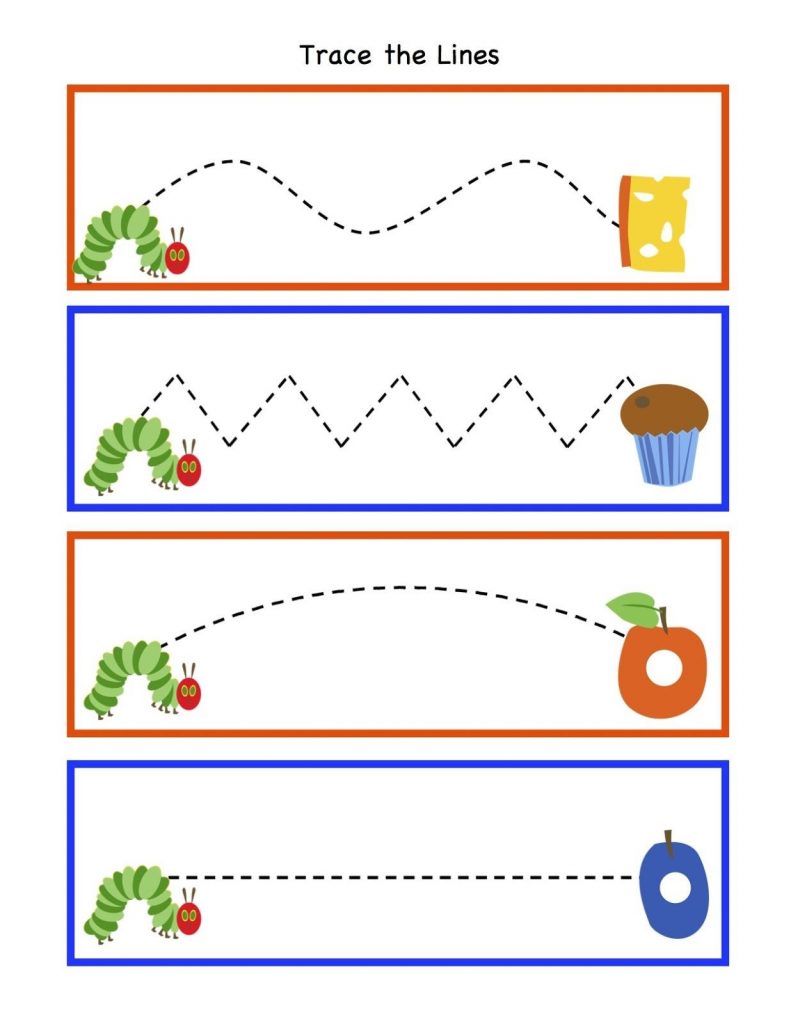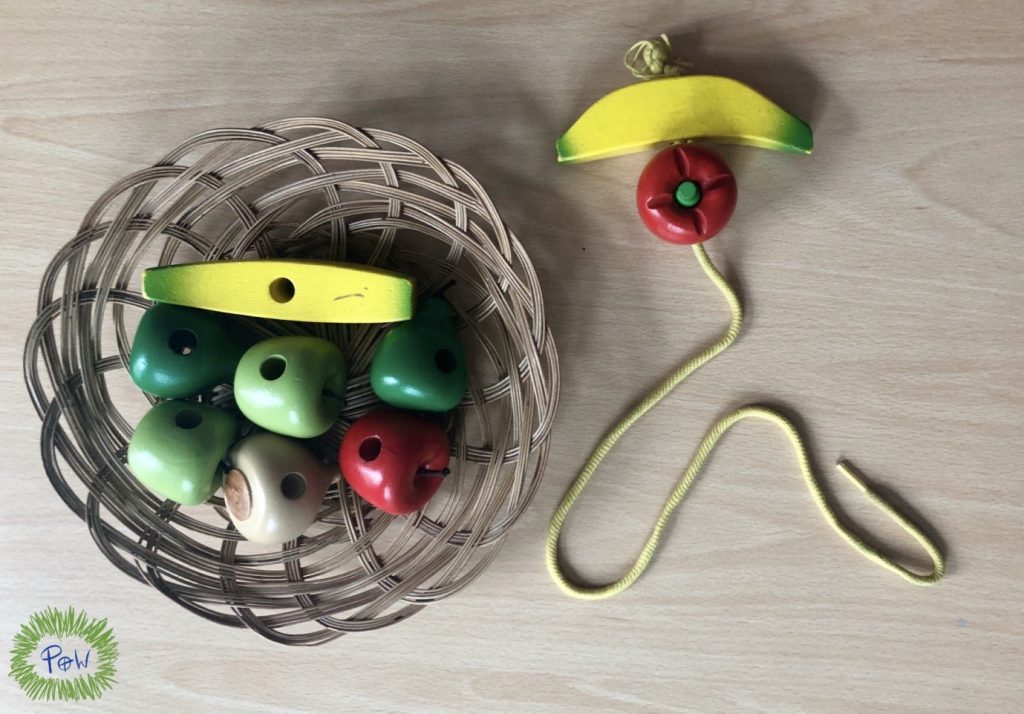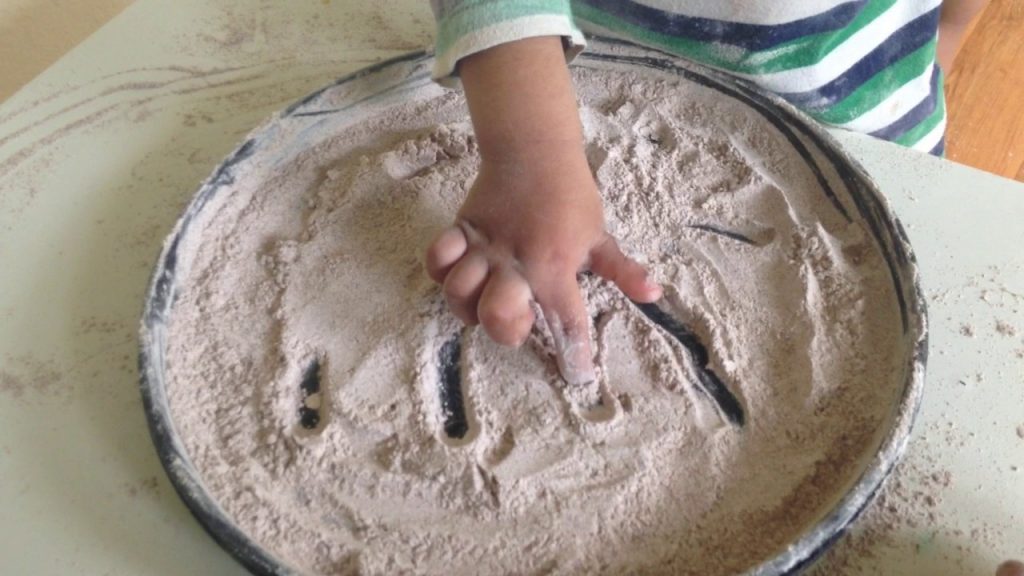Please Click HERE to See The Accompanying Videos
Measure
To demonstrate an understanding of the basic concept of ‘big’ and ‘small’ M5
Look at the pictures of the caterpillar at the different stages of his life. Compare the size of the egg, the tiny caterpillar with the great big fat caterpillar. See if your child can say or point to which is small and big.
To compare the overall size of one object with another (minimal difference) using comparative language – bigger / smaller/ largest / smallest M6
Ask your child which of the caterpillars is the biggest? What happens when the caterpillar eats lots of food? Does he get bigger or smaller?

Writing
To trace, overwrite or copy shapes and straight line patterns. M5
Encourage your child to trace simple line patterns. Create a simple outline of a big fat caterpillar for them to trace (oval shape) or some simple outlines of the foods he ate e.g a circle for an orange, a pear shape, a triangular piece of cheese.

To use writing tools with increasing control. M6
Use a range of writing tools for your child to experience, encourage short sessions of mark making and writing to offer opportunities to increase their control.
Offer fine motor skills activities to increase finger strength. E.g lacing, printing, mark making with finger tips in paint or sensory material e.g flour. Use threading to create your own caterpillar.


Reading
To derive some meaning from text, symbols or pictures presented in a way familiar to them. M5
Share the story book with your child. Show them the pictures and discuss what they contain, read one or two simple words and point to these as you read to familiarise your child with what they look and sound like.
To enjoy interaction with others in the storytelling process, and are enthusiastic when engaging in reading activities M5
Sit and share the story book with your child, encourage them to help you to tell the story.
Pupils enjoy being a ‘storyteller’ and will mimic telling a story to others. M6
Offer your child the story book to give them the opportunity to tell the story to you or perhaps to their teddies.
Speaking and listening
To initiate and maintain short conversations using their preferred medium of communication. Pupils ask simple questions to obtain information eg “Where’s my coat?”. Pupils name objects which fall into familiar groups or catergories EG animals that live on a farm, colours, children in my class. M6
As you read and share the book together look at the pictures, see if your child can name the fruits and some items in the pictures – the sun, moon, leaf, egg. Ask simple questions about the caterpillar e.g. what did he turn into? Encourage your child to ask questions about the story, stop after each page and look at the pictures to support this.
To recognise when a familiar rhyme song or story is dramatically changed and comment upon this M6
As you read the story change the repetitive line and see if your child notices or at the end when the caterpillar emerges from the chrysalis pretend he has turned into a different animal, see if your child notices and says anything.
Science
To respond to simple scientific questions, for example, ‘Show me the flower’ ’Is this wet/dry?’ ‘Showing’, ‘demonstrating’ ‘trying out’ ‘responding’ etc may be done by any means appropriate to the pupil’s preferred mode of communication and physical abilities. M5
Share the story book with your child. Ask about what happens to the caterpillar, use words like changes, cocoon, butterfly. Talk about when he emerges from the egg – it is morning and he eats during the day and then it is night. Introduce the idea that night follows day. See if your child can identify day and associate it with the sun, night with the moon – point to each of these pictures as you talk about it.


PSHE
To can find an item which is identical to a given item M5
See if your child can match fruits with another the same. Show 2 different pieces of fruit and then offer one the same, see if your child knows which it matches.
To respond appropriately to a simple request from an adult to engage independently with one aspect of a self-care task/process. M6
Before cooking or after painting or art and craft activity ask your child to wash their own hands. You could also ask them to roll up their sleeves, put an apron on or respond to a request to get dressed, go to the toilet or brush their teeth.

Humanities
To know they took part in past events and they listen and respond to familiar stories about their own past M5
Having shared and read the story of the very hungry caterpillar earlier in the day ask your child which story you read. See if they can remember any bits from the story.
Recap on any activities you have done together that relate to the story.
To recognise and make comments about themselves and people they know in pictures of the more distant past M6
Share some photographs of you and your child. See if they can identify who is in the photographs and what you were doing at the time.
Art and Design
To show an intention to create. They start to use tools, materials and simple actions to produce a piece of work. M6
They imitate the use of tools, materials and simple actions, for example, cutting M6
Make a hungry caterpillar from junk modelling, print with some of the fruit he ate, use a variety of cut out pictures of foods to create a collage offering opportunities to use tools e.g scissors, glue to stick materials.
Demonstrate how to make a butterfly symmetry painting by creating painted pattern on one side of paper and folding it over to press and create two halves the same.



Cooking
To demonstrate preferences for products, materials and ingredients, for example, selecting a preferred filling for a sandwich. M5
Talk about the foods the hungry caterpillar ate. Which foods do you like? Make a sandwich together and ask your child to select their preferred filling from two of the foods the caterpillar ate – cheese or sausage. Ask your child to choose what they would like yo eat for their pudding, offer fruit the caterpillar ate each day of the week, apple, orange, plum, strawberries, pear.
To watch others using a basic tool and copy the actions e.g rolling pin M6
Show your child how to use the knife to spread the butter then let them have a go themselves with support and supervision.
PE / Dance
They explore a variety of movements and show some awareness of space. They understand some basic concepts, for example, taking big and little steps in movement activities or placing big and small balls in different baskets. M5
Create a simple set of movements to illustrate the life cycle of a butterfly. Make a small ball to show the egg, slowly crawl along the floor to be the tiny caterpillar and then make yourself as big as you can to be the big fat caterpillar before turning going back into a small ball to be the chrysalis before becoming a beautiful butterfly who moves quickly whilst flapping their wings.

Resources:
